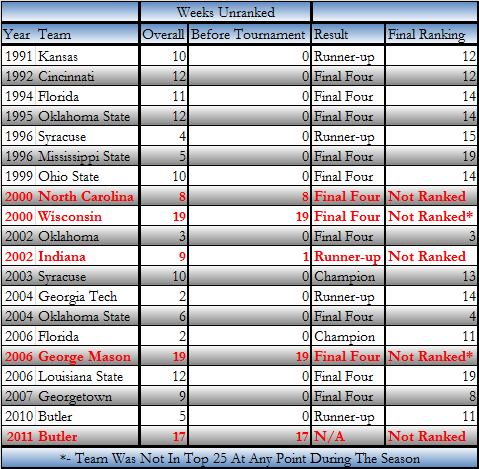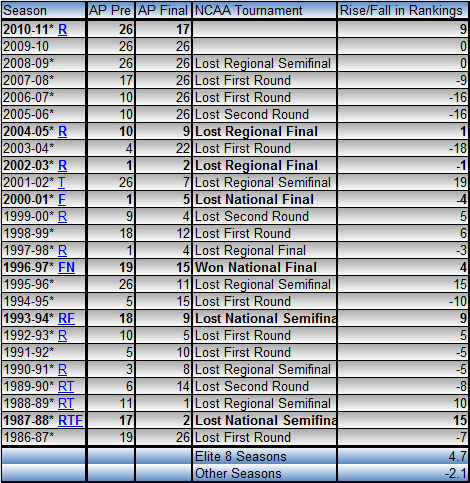With a win today against Florida, Butler joined a some rare company. They became the fifth unranked team to reach the Final Four since the Top 25 era started in 1989. The other four teams were
UNC in 2000,
Wisconsin in 2000,
Indiana in 2002, and
George Mason in 2006. Of those teams, only Indiana made it to the Championship Game, which is not too surprising when you look at the table below. Indiana was ranked up until one week before the tournament and was unranked for a smaller portion of the season than the other four teams. 2000 UNC was unranked for the last 8 weeks of the season, this year’s Butler was unranked for the last 17 weeks of the season, and amazingly; 2006 George Mason and 2000 Wisconsin were unranked for the entire season. There were also 15 other teams who made the Final Four while being unranked at some point in the season, but they were ranked by the time the tournament started.
 |
| “Weeks Unranked” Before Tournament is How Many Consecutive Weeks Unranked Before Tournament. |
Let’s look at each instance individually. As stated earlier, this season’s Butler team was unranked for the last 17 weeks of the season. Their run is not as improbable as it seems when you look at their body of work. Their absence from the Top 25 had more to do with the poll voters overlooking them than their actual play. While they did have a three-game hiccup in conference play, they still had good conference and non-conference records. One would think that last year’s run would have given them some benefit of the doubt with the voters. They were undoubtedly overlooked because they lost Gordon Hayward to the NBA and bias against the mid-major conferences.
The 2000 Tarheels had sufficient talent to make the Final Four and they displayed that talent during their 9-4 run through their early non-conference schedule. But when they got into conference play they began to struggle and dropped from the top 25 for good when they lost
4 conference games in a row, the last being to a weak Florida State team. A good showing in the ACC tournament would have probably gotten them back in the Top 25, but they lost in the first round to Wake Forest. When they hit the NCAA tournament as 8
th seed their talent began to gel and they got lucky when
Kenyon Martin got injured and the 2
nd seed Cincinnati lost in the 2
nd round to Tulsa. Bottom Line: Their ranking, or lack thereof, said they shouldn’t have made the Final Four, but their talent warranted their “surprise run”.
The 2000 Badgers stayed unranked the entire season and I can’t really explain their run; except to say that their slow-paced, defense first style, combined with some luck, helped them a great deal during the tournament. George Mason in 2006 also had a inexplicable run to the Final Four; it was a true Cinderella story.
If the last 20 years is any guide, Butler should probably lose in the Final Four, but if recent history and common sense prevail, you can expect them to at least get to the title game.
Other Interesting Posts:





